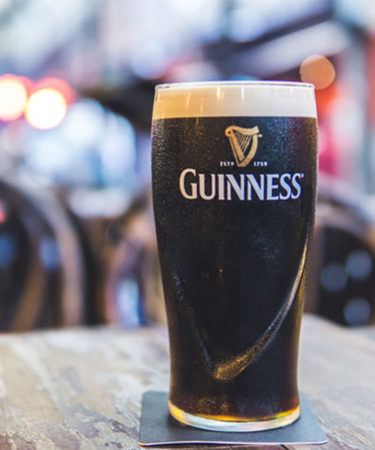
When it comes to Guinness and quality, most drinkers have one, penultimate question. Does the beer taste better in Ireland?
Chris McClellan, senior ambassador for the brand, perhaps unsurprisingly says no. The most common myth surrounding Guinness is just that, McClellan says — a myth.
That’s not to say all Guinness is poured equal, nor would you be wrong in feeling you’ve sampled a pint outside of Ireland that doesn’t match up to the “Irish Champagne” served on the Emerald Isle. The quality of a pint of Guinness is determined by six factors relating to the beer’s storage and service.
Don't Miss A Drop
Get the latest in beer, wine, and cocktail culture sent straight to your inbox.Want the recipe for a perfect pour? Here are all the factors that affect the quality of your Guinness.
CLEAN LINES
Bars and restaurants should clean their draft lines every two weeks, minimum. If they don’t, they risk a build of yeast, bacteria, and mold, as well as “Beer Stone,” a mix of calcium and mineral deposits that contributes off flavors.
“If you really, truly want to taste beer the way that it was intended, or the way that the brewer made it, you have to pay attention,” Angela Steil, Advanced Cicerone, told VinePair in 2018. “It doesn’t matter if you have the best beer in the world; if it’s put through shitty lines, you are going to get shit beer.”
TEMPERATURE
Incorrect pouring temperature contributes to “90-plus percent of the draft issues you experience at a pub or bar,” McClellan says. Guinness should be poured at 38 degrees, which ensures it isn’t over-carbonated. By the time it’s handed to a customer, the temperature will be somewhere between 38 and 43 degrees.
GAS MIXTURE
Guinness Draught was born in the 1950s after a small team, led by mathematician Michael Ash, invented a dispensing system for Guinness called “nitrogenation.” (Prior to this, pub owners sold room-temperature Guinness that they bottled themselves direct from wooden kegs.)
The mix of 75 percent nitrogen and 25 percent carbon dioxide (CO2) is known in the industry as “Guinness Gas,” and without it, there’d be no such thing as nitro beers. “You cannot pour Guinness on anything but that gas mix,” he says. “[It] helps balance the pressure and optimize the pour.” It also gives Guinness its iconic “cascading head.”
GLASSWARE
While Guinness has its own branded “Gravity Glass,” in our experience, any tulip pint glass works just fine. The inward curvature toward the lip of this style of glass strengthens beers’ head and helps provide the ideal amount of thick, creamy foam (“between half- and three-quarters of an inch,” McClellan says).
FRESHNESS
“Beer is like bread,” McClellan says, and, just like any other food product, it’s best served fresh. Good keg rotation is essential to achieving this. “First keg in should be the first keg out,” he says. This is as true for Guinness as it is for all beer.
POUR
Pouring a Guinness is a notoriously slow, exacting process. For the first three-quarters of the pour, the glass should be held at a 45-degree angle. The pint should then be left to settle completely, before being topped up by pushing the handle away from the pourer for more control.
For a nice, domed foam, Guinness should be poured “just proud of the rim,” McClellan says. As for those artistic shamrocks? The brand doesn’t have an official stance.
